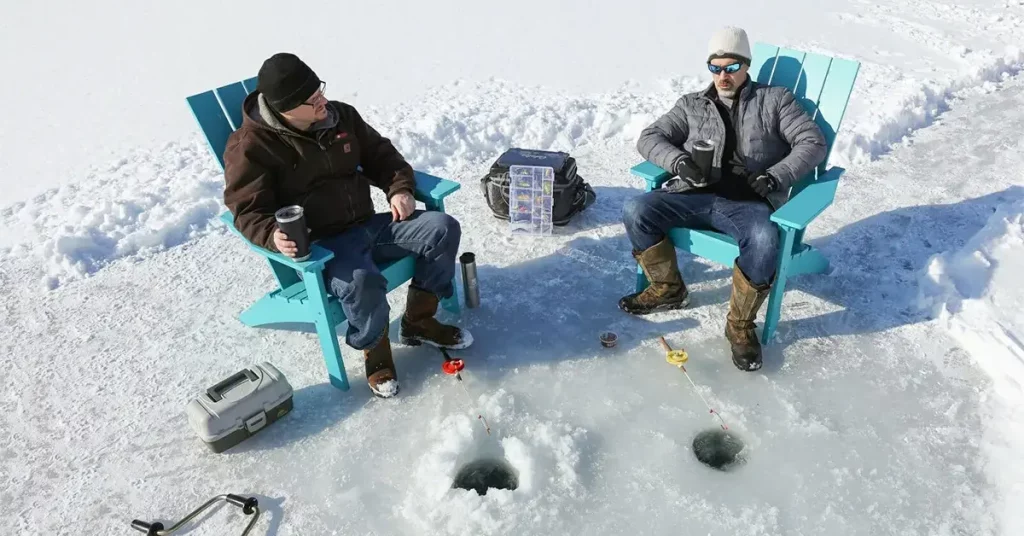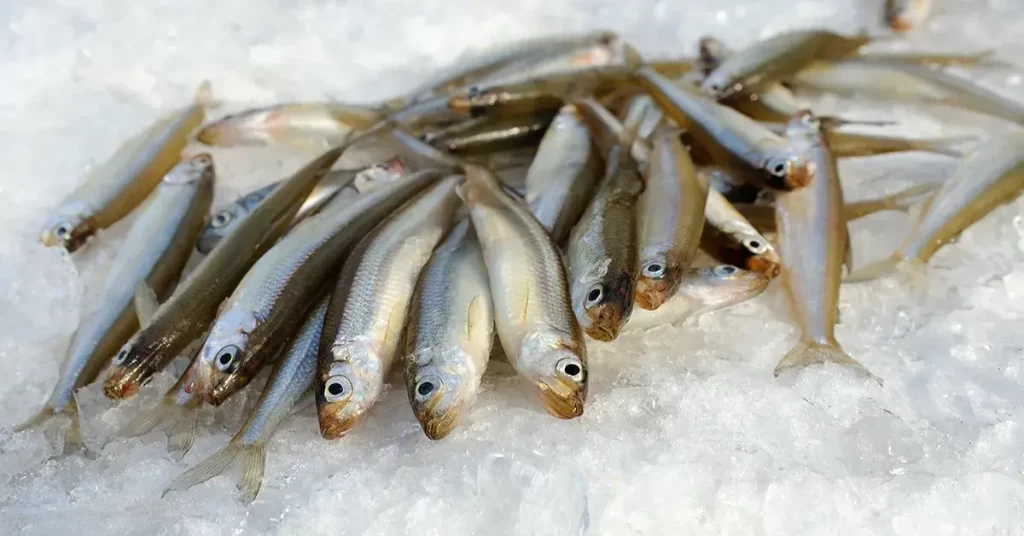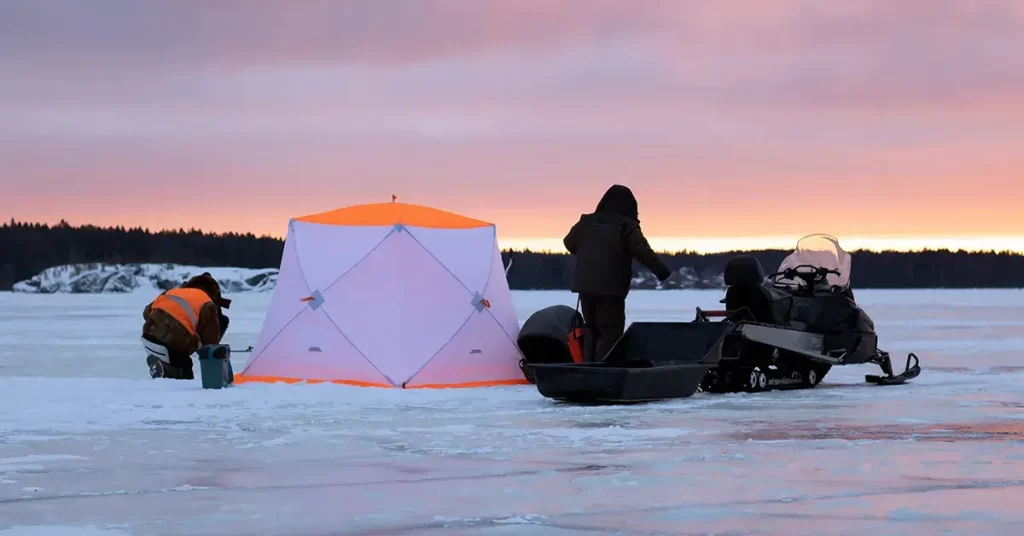When it comes to ice fishing – preparation is key. Having the right gear means the difference between filling up a cooler with delicious perch or walleye, or heading back early because you can’t feel your toes and fingertips.
While most people are familiar with ice augers, tip-ups, chisels, and other ice fishing tackle, equal consideration should be given to wearing the right clothing for the conditions.
Back in the day, ice fishermen bundled up in bulky down snowsuits, heavy blue jeans, and sweatpants. Modern materials still require layering, but feature lightweight and breathable fabrics which provide excellent thermal protection and mobility while still being completely waterproof.
Let’s dive into what to wear when ice fishing, how to dress for different situations, and how to stay warm when it’s colder than the surface of Mars outside!
Layering
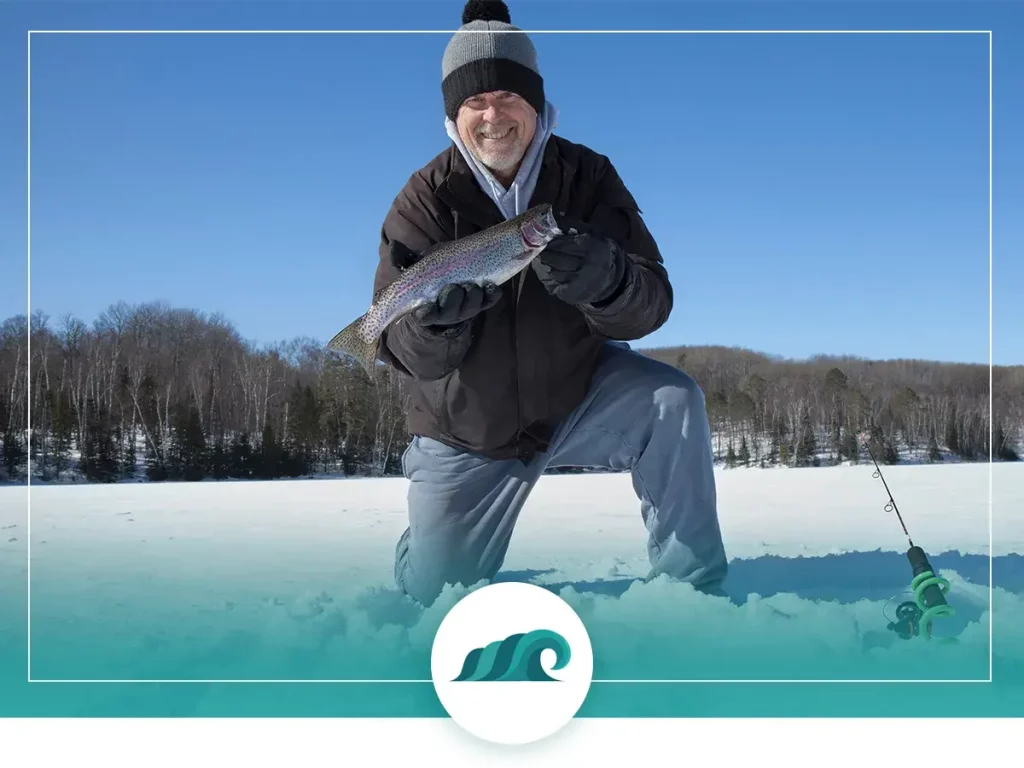
The key to dressing for ice fishing (and other cold-weather activities) is layering. Layering gives you the ability to remove or add layers as needed – depending on the weather conditions.
Wearing layers made from different materials allows you to utilize each layer for a specific purpose.
Base layers made from lightweight, breathable materials work to wick away sweat and water to keep you dry and warm. Middle layers are often made from wool, fleece, or micro-down – which works excellently to insulate and trap warmth – while also being breathable. Interestingly, wool is one of the only materials that keep you warm even when it’s wet.
Outer layers like bibs and jackets create a waterproof shell that prevents moisture from getting in and keeps heat from escaping outward.
This outer layer should have no gaps for heat to vent out, which is why bibs and jackets overlap and typically feature cuffs to seal off the wrist and waist areas.
One-piece snowsuits work well for this, but because they can’t be broken down into top and bottom pieces, they’re ideally suited to wear in extremely cold temperature ice fishing.
Footwear
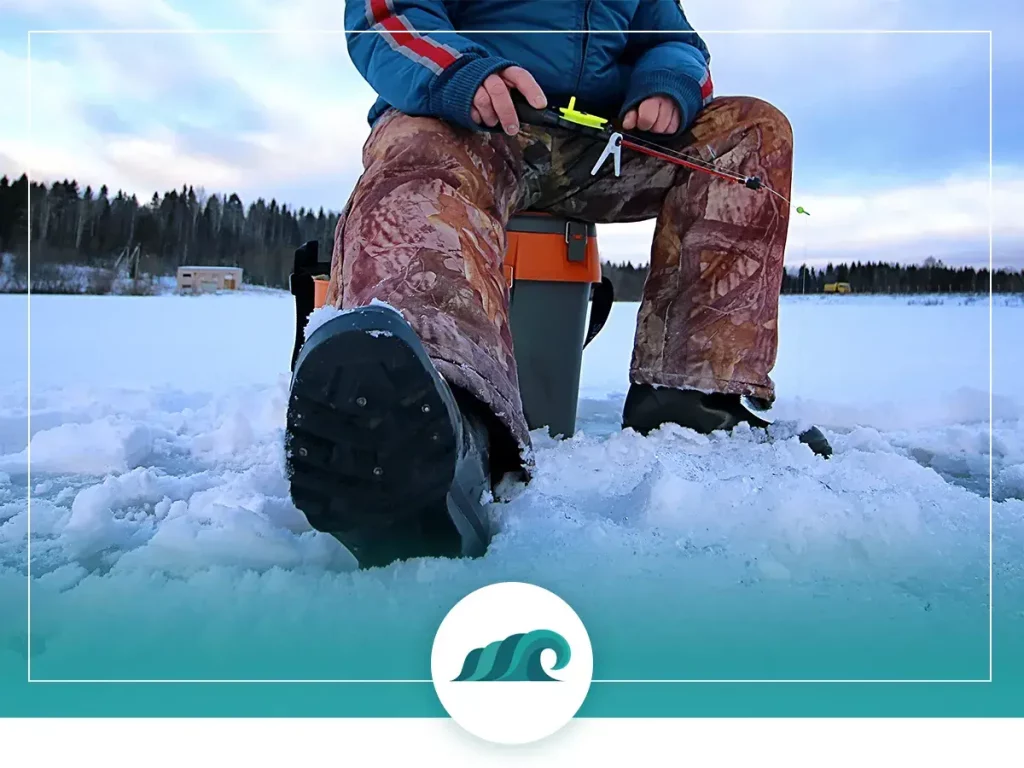
Footwear might be the most important consideration when suiting up for ice fishing. Your feet are your connection with the ice, and need protection from the cold, moisture, and must provide adequate grip on the ice surface.
Boots
A good pair of waterproof insulated winter boots are a must. Ice fishing requires you to drill multiple holes in the ice – which means your feet will come in contact with slush, ice-cold water, and snow. While you can get by with regular boots in a pinch, having a boot that’s completely waterproof will ensure absolutely no water seeps inside.
A good pair of boots will typically feature a removable liner, which allows you to quickly dry out your boots after a long day of fishing. Many also feature an adjustable snow collar – preventing snow or slush from working its way into the boot’s interior. Most boots will come with a temperature rating indicating the lowest temp it can handle.
If you need additional traction, then you’ll want to use ice fishing cleats over your boots or winter shoes.
Socks
While good boots are essential, wearing the right socks for the job should not be ignored. Just like the rest of your body, layering socks work well in colder temperatures. Moisture-wicking socks work well as a base layer, pulling moisture away from your feet and keeping them bone dry. Then a heavy-duty wool sock on top of that provides warmth and insulation from the cold.
Finally, a pair of cleats or “creepers” provide extra traction in icy, slippery conditions. These work similarly to tire chains for off-road winter driving. If you’re fishing on flat ice without much snow on it, then cleats will allow you to walk on the ice without worrying about a painful slip and fall. Also, if you’re dragging a heavy ice sled behind you, the extra traction provided by cleats can really help with gaining traction on the ice.
Gloves
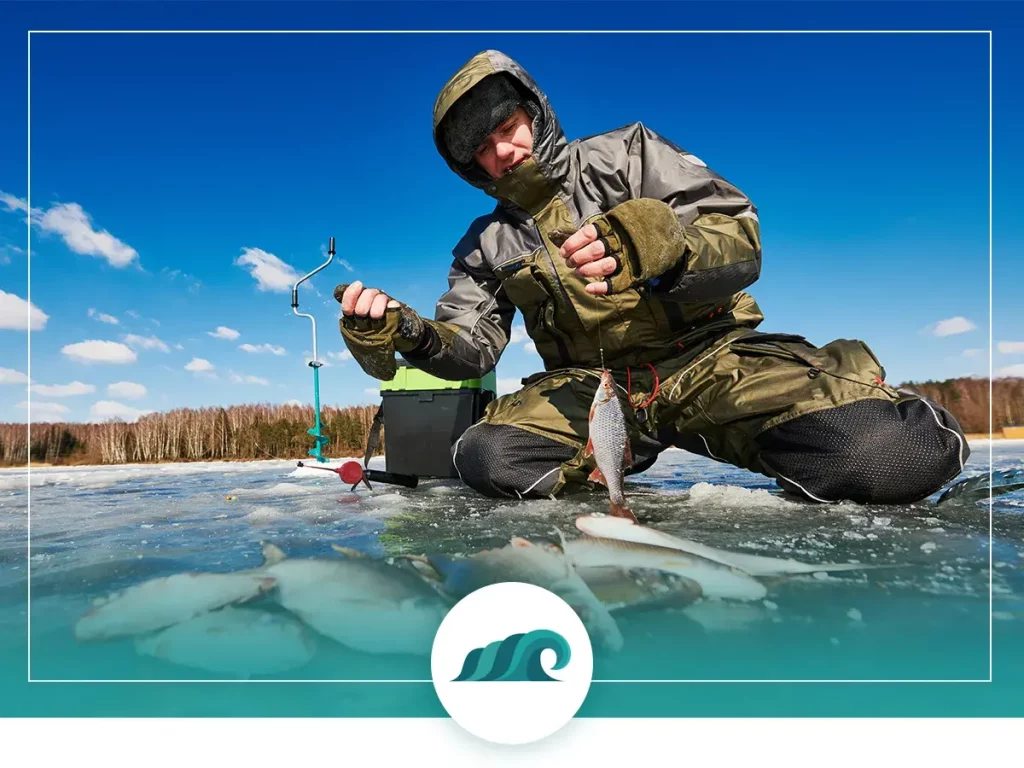
Protecting your fingers and hands from the cold is extremely important for ice fishing. Everything you do while ice fishing requires your hands. If they get too cold, blood flow will reduce, which means your fingers won’t function properly and your reaction time can slow down.
Keeping your fingers warm will not only make you more comfortable, but it also preserves your dexterity so you can use a hand auger, set up tip-ups, or reel in your catch.
Ice fishing gloves are often made from fleece-lined neoprene – which provides warmth, waterproofing, as well as good grip and finger dexterity. Some feature slit fingers for the thumb and index fingers – allowing you to bait your line, tie hooks and other tackle, or perform other tasks requiring finesse without having to remove your gloves.
While neoprene gloves work well for most situations, when it gets really cold you’ll want another larger pair to layer on top. Mittens work well for this, as they trap in heat better than gloves do.
Additionally, packing a few hand warmers in your kit can come in handy when the temperature dips significantly.
Outerwear
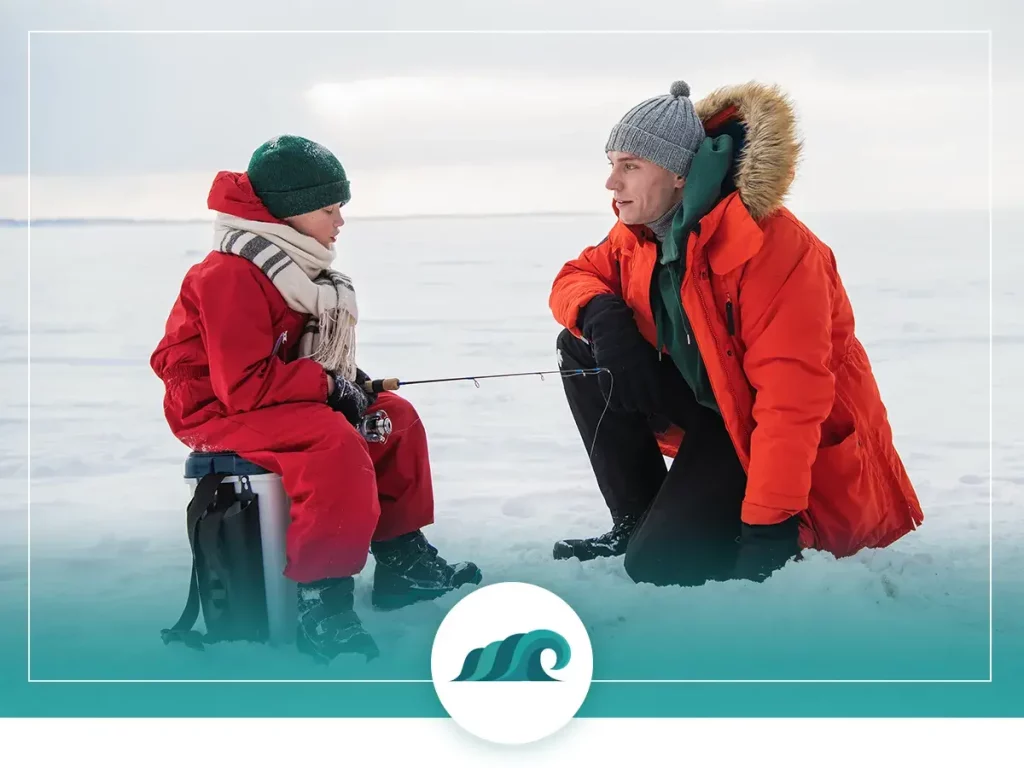
As mentioned previously, layering is key when it comes to what to wear for ice fishing. Generally, you’ll want to wear at least three main layers (base layer, mid-layer, and outer layer/shell). I’ll break down each of these in detail.
Base Layer
A base layer should be lightweight, breathable, and most importantly: moisture-wicking.
Modern synthetic materials like microfiber polyester work extremely well for this – manufacturers use various names for this material, some of the most popular are Dri-Fit, Climatalite, ClimaCool, and HeatGear. It’s important that this base layer is form-fitting. This helps with moisture-wicking and prevents sweat build up.
Whatever you decide to use as a base layer – stay away from cotton T-shirts or long underwear. These absorb moisture and act like a wet mop against your skin.
Mid Layer
The mid-layer (or layers) acts to insulate, provide warmth, and may provide some windproofing as well. Various materials can be used for this, but merino wool, fleece, and light down all work well. If you plan to remove your jacket at some point, then a light down layer with some degree of windproofing is an excellent choice.
Outer Layer / Shell
Outer layers have multiple roles, but most importantly they need to be waterproof, wind-proof and prevent warmth from escaping.
Modern ice fishing jackets and bibs have come a long way over the last few years and feature a number of advancements that make them invaluable to the modern ice angler. Cutting edge materials like Gore-Tex and high denier nylon are lightweight, while still being durable and completely weatherproof.
Many feature padded knees and seats for comfortable kneeling and sitting on the ice. Sealed cuffs prevent warmth from escaping, while removable liners allow you to adjust the warmth level for different temperatures.
While one-piece snowsuits work well in extremely cold climates, they’re less than ideal for the average ice angler. Purchasing a separate jacket and bibs is far more practical, as you can easily remove the jacket if you start overheating.
Another recent advancement in outerwear is flotation technology. Flotation technology utilizes lightweight foam cells incorporated into the jacket or bib material that keep you afloat in the event of a fall through the ice.
Other than a good pair of ice picks, a flotation suit is probably the most valuable piece of ice fishing safety gear you can have with you on the ice. It will keep your head above water and afloat long enough for the cold shock-response to wear off so you can be rescued or extract yourself from the water.
Headwear
As the old saying goes – if it’s cold out, put a hat on! Your body loses most of its heat through your head, so keeping it properly insulated is key for fishing in cold temperatures.
While you can wear whatever hat style you happen to like (I’m partial to the fur-lined Russian hat), there are a few things to keep in mind when picking a good hat for ice fishing.
Firstly, you’ll want to ensure your neck and ears are covered and protected from the cold. A warm beanie or toque along with a good neck gaiter or face mask works well for this. Just like with the rest of your body, layering works well for your head – a lightweight balaclava or ski helmet liner works well as a base layer underneath a bigger, warmer hat.
Beyond keeping your head warm, a good pair of sunglasses can also come in handy on the ice. They’ll protect your vision from harmful UV rays (which amplify when they bounce off the white snow), as well as keep your eyes safe from rogue hooks. If you’re fishing from a snowmobile or quad, or it’s snowing heavily out, then a pair of ski goggles might be a good idea as well.
Wrap Up
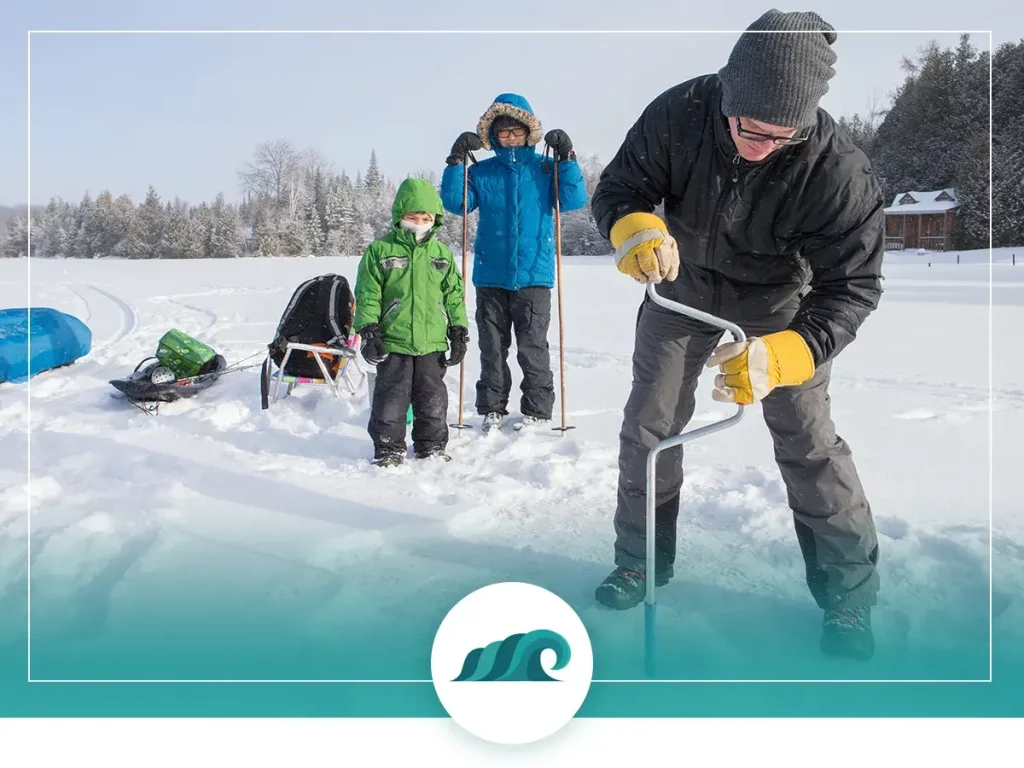
So, what should you wear when ice fishing?
The answer will depend on the temperature and weather conditions outside, your personal preferences, and what you have available! If you’re new to ice fishing, or you’ve been out of the game for a while, you’ll find that newer materials and fabrics offer major performance enhancements over the bulky snowsuits of old. Lightweight, breathable and waterproof materials are now commonplace, keeping you light and mobile, without restricting your range of motion.
If you’re interested in what to wear for fair weather fishing, check out my detailed post here.

